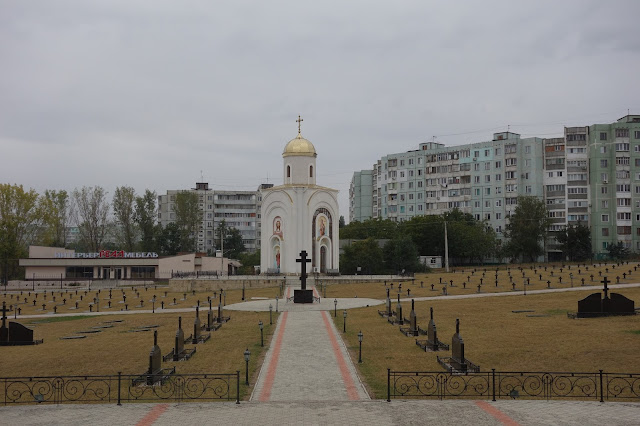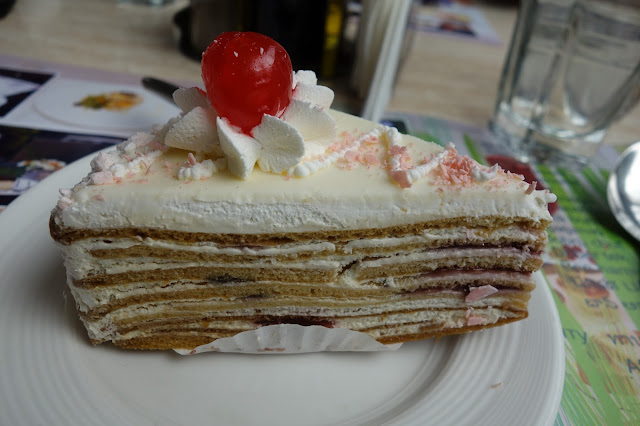and entering into bizarro world- I am going to post about our day in Transdniestria out of order- because I am facing the editing of thousands of Romanian photos and there are only 60 or so from the day we spent in this invisible country... so I am taking the easy way out and doing it first--- LOL
Transnistria (also called Trans-Dniestr or Transdniestria) is a partially recognized state located mostly on a strip of land between the River Dniester and the eastern Moldovan border with Ukraine. Since its declaration of independence in 1990, and especially after the War of Transnistria in 1992, it has been governed as the Pridnestrovian Moldavian Republic (PMR, also known as Pridnestrovie), a state with limited recognition that claims territory to the east of the River Dniester, and also the city of Bender and its surrounding localities on the west bank, in the historical region of Bessarabia. The names "Transnistria" and "Pridnestrovie" both refer to the Dniester River.
Unrecognised by any United Nations member state, Transnistria is designated by the Republic of Moldova as the Transnistria autonomous territorial unit with special legal status
After the dissolution of the USSR, tensions between the newly created Moldova and the de facto sovereign state of Pridnestrovie (which unlike the rest of Moldova did not wish to separate from the Soviet Union) escalated into a military conflict that started in March 1992 and was concluded by a ceasefire in July 1992. As part of that agreement, a three-party (Russia, Moldova, Transnistria) Joint Control Commission supervises the security arrangements in the demilitarized zone, comprising twenty localities on both sides of the river. Although the ceasefire has held, the territory's political status remains unresolved: Transnistria is an unrecognized but independent presidential republic with its own government, parliament, military, police, postal system, and currency. Its authorities have adopted a constitution, flag, national anthem, and coat of arms. However, after a 2005 agreement between Moldova and Ukraine, all Transnistrian companies that seek to export goods through the Ukrainian border must be registered with the Moldovan authorities. Most Transnistrians also have Moldovan citizenship, but many Transnistrians also have Russian and Ukrainian citizenship. The largest ethnic group is Moldovan (32.1%), who historically had a higher share of the population, up to 49.4% in 1926. (wikipedia)
So off we set one morning of the trip for our day in a place that the world refuses to acknowledge its existence... very strange- it is tied to the Soviet era Russia culturally and so that is why people visit- kind of a time machine to the past...
here is a little bit of the history surrounding it
On 31 August 1989, the Supreme Soviet of the Moldavian SSR adopted Moldovan as the only official language with Russian retained only for secondary purposes, returned Moldovan to the Latin alphabet, and declared a shared Moldovan-Romanian linguistic identity. As plans for major cultural changes in Moldova were made public, tensions rose. Ethnic minorities felt threatened by the prospects of removing Russian as the official language, which served as the medium of interethnic communication, and by the possible future reunification of Moldova and Romania. The Yedinstvo Movement, established by the Slavic population of Moldova, pressed for equal status to be given to both Russian and Moldovan. Transnistria's ethnic and linguistic composition differed significantly from most the rest of Moldova. The share of ethnic Russians and Ukrainians was especially high and an overall majority of the population, some of them ethnic Moldovans, spoke Russian as a mother tongue. Ethnic Moldovans accounted for less than 40% of Transnistria's population in 1989. All UN member states consider Transnistria a legal part of the Republic of Moldova. Transnistria has its own central bank, which issues Transnistrian currency, the Transnistrian ruble. It is convertible at a freely floating exchange rate but only in Transnistria. (wikipedia)
There really isn't a lot to see there- one Fortress that has been reconstructed (and contains a small museum) and a few monuments and very clean wide streets with little traffic- so not a ton of photos but you will see. You must have a visa but since the "country" isn't really one your passport does not get stamped- only a piece of paper is issued with a time limit by which you must leave the country- roughly twelve hours! (not problem it is a little place LOL)
having accomplished the border crossing our first stop was a monument-
then we crossed the street and headed into a grocery store SHERIFF for a WC stop- very very clean bathrooms!
then off to the fortress in Bendery-
then on to some more monuments-
a Lenin statue outside parliament-
the post office-
a market with lovely produce and meat and cheese-
then a stop at a cognac makers-
on to the Soviet style Russiya hotel - where we had a fabulous lunch!
before heading back to Chisinau in Moldova and our swanky hotel there.... the next morning we were picked up by some guy who didn't answer to the name of our booked driver and who spoke no English - we got in the car with him and hoped we were bound for Odessa in Ukraine....








































No comments:
Post a Comment